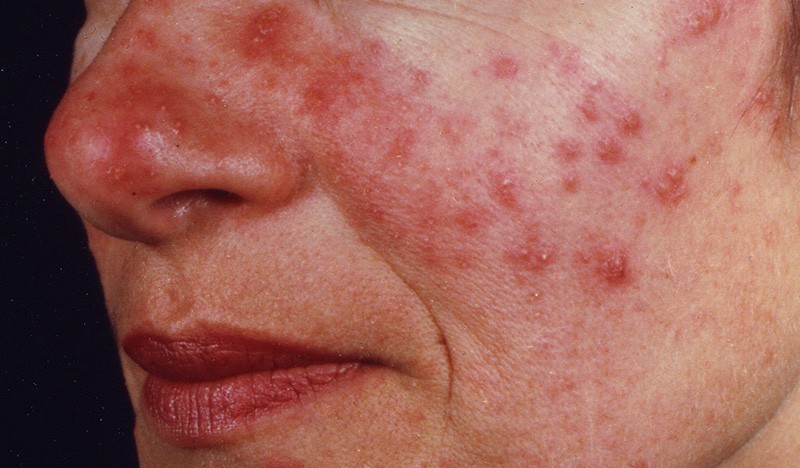ACNE ROSACEA

What is acne rosacea?
Rosacea is a skin disorder that commonly occurs in middle-aged and older adults characterized by vascular dilation of the central face, including the nose, cheek, eyelids, and forehead. Vascular dilation causes an increase in blood flow to the area leading to flushing and redness of the overlying skin. Rosacea is a chronic disorder that can have periods of flares and remission. Patients with rosacea have an increased susceptibility to recurrent flushing reactions that may be provoked by a variety of stimuli including hot or spicy foods, drinking alcohol, temperature extremes, and emotional reactions.1
Rosacea goes through as series of stages, some more severe than others. The earliest stage is characterized by facial redness (particularly on the nose and cheeks, but also on the forehead, chin, and occasionally the neck) and telangiectasias (typically on the cheeks). Telangiectasis is an increase in spider-like blood vessels on the face. Over time patients with rosacea may develop severe sebaceous gland growth that is accompanied by papules, pustules, cysts, and nodules. Inflammation of these papules, pustules and nodules can look similar to those in acne vulgaris, with the exception of a lack of comedones (whiteheads and blackheads) in rosacea.
There are several different subtypes of rosacea, but certain features are necessary for diagnosis. The National Rosacea Society Expert Committee on the classification and staging of rosacea has developed guidelines that recommend the presence of one or more of these primary features for diagnosis:
- Flushing (transient redness)
- Non-transient redness
- Papules and pustules
- Telangiectasia
Secondary features can also occur in conjunction with primary features, these include:
- Burning or stinging
- Plaques
- Dry appearance
- Edema (swelling)
- Ocular manifectations: irritated blood shot eyes
- Peripheral involvement of body
- Phymatous changes: A red, bulbous nose
What causes acne rosacea?
Rosacea most commonly occurs in patients between ages 30 and 50 years, although it has been reported in younger individuals. Individuals with fair skin, light hair and eye color, and easy or frequent blushing or flushing are more susceptible to rosacea. Generally women are more commonly affected, however men with rosacea are more severely affected. The cause of vascular dilatation in rosacea is unknown, although factors that trigger an individual’s immune response may worsen symptoms. There are some hypotheses about how acne rosacea is formed:
- Hair follicle mites: Also called Demodex folliculorum and Demodex brevis, these mites are thought to contribute to inflammation.
- Bacterial overgrowth of small intestine or Helicobacter pylori gut infection: Patients with certain bacteria in their gut may have a higher susceptibility for rosacea.
How is acne rosacea treated?
Acne rosacea is a chronic disease, making disease control rather than cure the goal of therapy. Initial therapy involves:
- Avoid sun exposure. Use sunscreen daily.
- Avoid prolonged activities and exertion in hot weather.
- Try to reduce stress and employ relaxation techniques like deep breathing and yoga.
- Limit spicy foods, alcohol and hot beverages.
Certain antibiotics, either oral or topical, may help control skin eruptions. Topical antibiotics or benzoyl peroxide are the initial treatments of choice to reduce inflammation. Topical metronidazole and azelaic acid are also frequently used. If the disease cannot be controlled with topical antibiotics, oral agents such as tetracycline, minocycline or doxycycline can be added. In some severe cases, unresponsive to first line therapies, isotretinoin can be used. Since acne rosacea is a chronic disease, metronidazole may be applied once daily for maintenance therapy.
References:
1Wilkin JK. Effect of subdepressor clonidine on flushing reactions in rosacea. Change in malar thermal circulation index during provoked flushing reactions. Arch Dermatol 1983 Mar;119(3):211-4.


